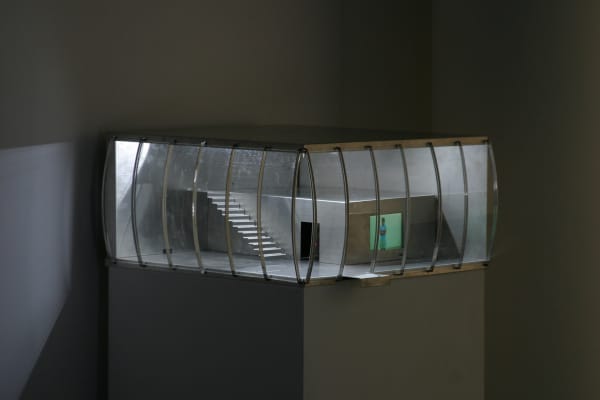Jeong-ju Jeong has spent most of his career creating works that explore the structure of contemporary buildings in compelling ways. Through the designs of contemporary architects such as Le Corbusier and Frank Lloyd Wright, the conventional hexahedral structures of buildings have become diversified in an attempt to maximize spatial functionality, interior lighting (through light inducement and reflection), and the organic relationship between interior and exterior spaces. Today, every city is covered by the façades of such buildings, which serve as both ornamental surfaces and functional membranes, while also operating as visual symbols. Of course, we cannot help but recollect the historical, political, social, economic, and cultural memories imbued in these concrete cubes, where so many of the most important events in contemporary history have taken place.
In earlier works, Jeong constructed miniature buildings, which he then filmed with a small camera that moved through the structure on a rail. Like a cinema special effect, the resulting videos seem to have been shot inside huge, life-size buildings. Over the past few years, Jeong has begun introducing variations in the reflection and projection of light on the walls of his buildings, emulating the effect of the sun constantly moving along the ecliptic. Creating dramatic narratives through shadows cast by exaggerated light sources, the installations of the buildings emphasize darkness and night. The videos, on the other hand, represent daytime with a bright and optimistic array of light and color. With an abstract composition accentuated through numerous light sources and artificial editing, this temporality of light gives Jeong’s recent works a fantastic and subjective ambience, as seen in Haedeun Museum Lobby (2019).
Jeong’s abstract combination of architectural space and projected light recently entered a completely new stage with Façade2019, which juxtaposes various quadrilateral components and color planes of the same size, simultaneously evoking the minimalism of Donald Judd and the architectural modules of Le Corbusier. Connected side-by-side, the different cubic structures and color planes yield the sensation of a city street with multifarious façades. The artist previously achieved a similar effect in Tower (2017), in which miniature house modules were vertically stacked. The architectural context continues to become simpler and more abstract in the 2020 works, Horizontal Façade and Persfektive.
In some instances, Jeong has used the relationship between architectural space and projected light to evoke the historical memories of iconic buildings, such as Sangmugwan during the Gwangju Democratization Movement. At the same time, however, he continues to experiment with variations in the core elements of the interrelationship between space, plane, and light. Of particular interest is the way in which the “complex viewpoints” that are shown in detail in Jeong’s miniature buildings have lately become embedded, allowing his interest in “frontality” to take precedence. Through his complex compositions, the view from inside to outside is expressed as overlapping planes, all of which face the front, recalling cubism. Hence, for Jeong-ju Jeong, façade is indeed becoming a venue for new spatial-temporal combinations and entertainments.







